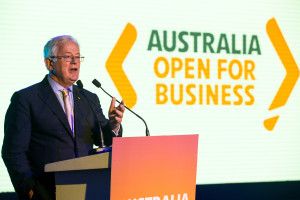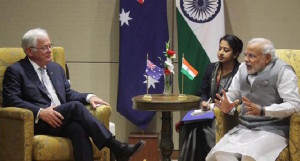Australian business looking at India as ‘new China’
By Rekha Bhattacharjee
Those Australians who are worried over the slowing Chinese economy may have some reasons to smile as Canberra is already working desperately to stitch up a Free Trade Agreement with the world’s second-most populous country – India.
If everything goes according to the Australians’ plan there is every reason to believe that India would become one of the largest trading partners of Australia. She has the potential to become what is being called in some circles as Australia’s “new China” – the largest trading partner at this stage.
The Australian eagerness to open such a vast market as India to its service and manufacturing sectors is reflected through the statements made by its federal ministers.

12 January 2015, New Delhi, India : Guests listen to Andrew Robb, Australian Federal Minister for Trade and Investment at the Australian Business in India Week Gala opening night at the Australian High Commission with 450 delegates from Australian busine
“We are working through the night … putting pressure on them (India) to help us to get to the point where we can have a similar, very positive agreement,” Treasurer Joe Hockey told a conference held in Canberra recently. Joe Hockey’s statement came after the China-Australia Free Trade Agreement (ChAFTA) was signed mid-June.
Canberra intends to finalise a similar FTA with New Delhi by the end of this year.
A number of commentators are writing on how Australian and Indian geopolitical and economic interests are converging and how they can harness the synergies to the benefit of both the parties. If the signals being emitted from South Bock are being interpreted correctly, India is also showing some enthusiasm to conclude the negotiations for the Comprehensive Economic Cooperation Agreement (CECA) this year.
While the Liberal think tank could have 2016 elections in their sight, the Narendra Modi-led Indian government seems to be on an overdrive to propel what is often lauded as a tiger economy into accelerated growth.
Even though the Indo-Australian FTA negotiations commenced some seven years ago, it’s the leadership of Narendra Modi and Tony Abbott which has added, as if, rocket fuel to the process. The clearly noticeable acceleration came after the Australian PM visited New Delhi and his Indian counterpart came Down Under in November last year.
At this stage, the two-way trade between the Indian Ocean rim countries is pegged at around A$15 billion which is just ten per cent of the value of Australia’s trade with its largest trading partner China (2013-14 figures).
The sense of optimism among the Australian stakeholders for India is definitely palpable. Australian corporate honchos, especially those linked with services sector, are particularly buoyed by the thought of massive revenue the Indian market can churn.
“Services represent around 70 per cent of Australia’s economy, yet just 15 per cent of our exports. This is an export we are determined to grow and there are strong prospects with India across a wide range of services, given it is one of the world’s most rapidly growing services markets on account of a rising middle class,” Australia’s Trade Minister Andrew Robb said in a statement recently.
A similar sentiment is being nursed by India’s famed IT services sector which has been asking for barriers to be removed.
Robb has endeavoured to allay such fears and in fact painted a picture which is very different from the one being shown by the naysayers.
“All of this suggests that India’s services sector stands to benefit enormously from trade and investment liberalisation.”
Besides IT service providers, Indian businesses such pharmaceutical, farm and fruit producers, etc also stand to gain from the trade agreement between the two countries. Australians have identified areas like engineering, health services, educating, contracting, construction, architecture, design and the agriculture sector.
It is believed around two thousand goods and services have been identified by both the sides to be included in the CECA.
“The free trade agreement has also made progress with the two sides agreeing on 1,800 line items… And it is just a small part of Comprehensive Economic Cooperation Agreement,” India’s High Commissioner Navdeep Suri told Indian community members in Melbourne recently.

Minister for Trade and Investment Andrew Robb showing-off his hockey prowess at a sports clinic during his visit to New Delhi for Australia Business Week in India.
It is also believed that, once CECA is signed, more investment would flow into Australia from India and vice versa. Indian foreign investment into Australia is worth almost $11 billion, with A$6.6 billion of Australian investment in India.
“There could be no better illustration of India’s potential to be at the centre of a new ‘Services Silk Road’ to drive growth in the world’s most economically dynamic region,” Robb said earlier this year.
It remains to be seen whether India would get an equal share in the revenue earned from the proposed ‘Silk Road’ or finish up just as full fare paying commuters.
(Rekha Bhattacharjee is a Sydney-based veteran journalist who also writes the opinion column ”˜Third Eye’ in The Indian Down Under. This article appeared in the Business Standard by the news agency IANS. Mrs Bhattacharjee can be contacted at vijay@hotkey.net.au)
Short URL: https://indiandownunder.com.au/?p=6018

